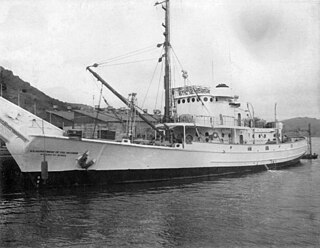| History | |
|---|---|
| Name: | USS Cohoes |
| Namesake: | Cohoes, New York |
| Builder: | Commercial Iron Works, Portland, Oregon |
| Launched: | 29 November 1944 |
| Sponsored by: | Mrs. W. W. Johnson |
| Commissioned: | 23 March 1945 |
| Decommissioned: | 3 September 1947 |
| Identification: |
|
| Recommissioned: | 1968 |
| Decommissioned: | 30 June 1972 |
| Struck: | 30 June 1972 |
| Identification: | ANL-78 |
| Honors and awards: | Nine campaign stars for Vietnam service |
| Fate: | sold for scrapping, 1 February 1973 |
| General characteristics | |
| Class and type: | Cohoes-class net laying ship |
| Displacement: | 775 tons |
| Length: | 168 ft 6 in (51.36 m) |
| Beam: | 33 ft 10 in (10.31 m) |
| Draft: | 10 ft 10 in (3.30 m) |
| Propulsion: | Diesel-electric, 2,500 hp (1,900 kW) |
| Speed: | 12 knots (22 km/h; 14 mph) |
| Complement: | 46 officers and enlisted |
| Armament: | 1 x 3 in (76 mm)/50 gun |
USS Cohoes (YN-97/AN-78/ANL-78) was a Cohoes-class net laying ship which was assigned to protect United States Navy ships and harbors during World War II with her anti-submarine nets. Her World War II career was short lived; however, she was recommissioned during the Vietnam War where she earned nine campaign stars.

The Cohoes-class net laying ships consisted of fifteen ships built near the end of World War II for the United States Navy, the last being commissioned shortly after war's end. They were similar in appearance and construction to the predecessor Aloe class, with slight differences in dimensions and displacement. Unlike previous net-laying classes, names were taken from a variety of place names, rather than from plants. All but two were decommissioned and put into reserve by the end of 1947, but most were reactivated at various times in the early 1950s and remained active until the early 1960s, when seven were transferred through lease or sale to several foreign navies. Two were transferred to other federal agencies; two were reactivated in the late 1960s and these served into the 1970s. Some of those transferred abroad were still active as late as 2007; none were lost in action.
A net laying ship, also known as a net layer, net tender, gate ship or boom defence vessel was a type of small auxiliary ship.

The United States Navy (USN) is the naval warfare service branch of the United States Armed Forces and one of the seven uniformed services of the United States. It is the largest and most capable navy in the world and it has been estimated that in terms of tonnage of its active battle fleet alone, it is larger than the next 13 navies combined, which includes 11 U.S. allies or partner nations. with the highest combined battle fleet tonnage and the world's largest aircraft carrier fleet, with eleven in service, and two new carriers under construction. With 319,421 personnel on active duty and 99,616 in the Ready Reserve, the Navy is the third largest of the service branches. It has 282 deployable combat vessels and more than 3,700 operational aircraft as of March 2018, making it the second largest and second most powerful air force in the world.


















